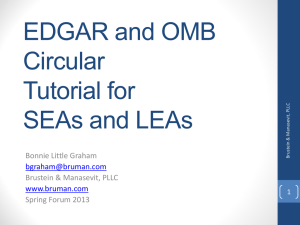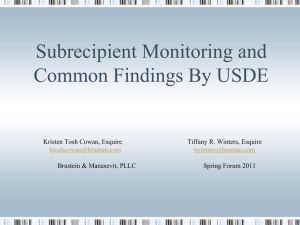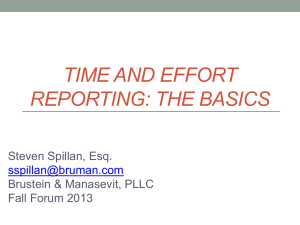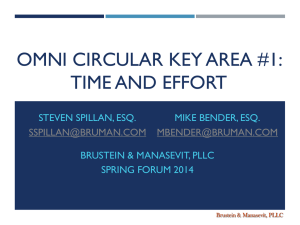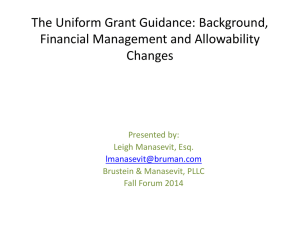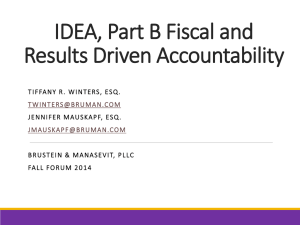IDEA: Results - Brustein & Manasevit
advertisement
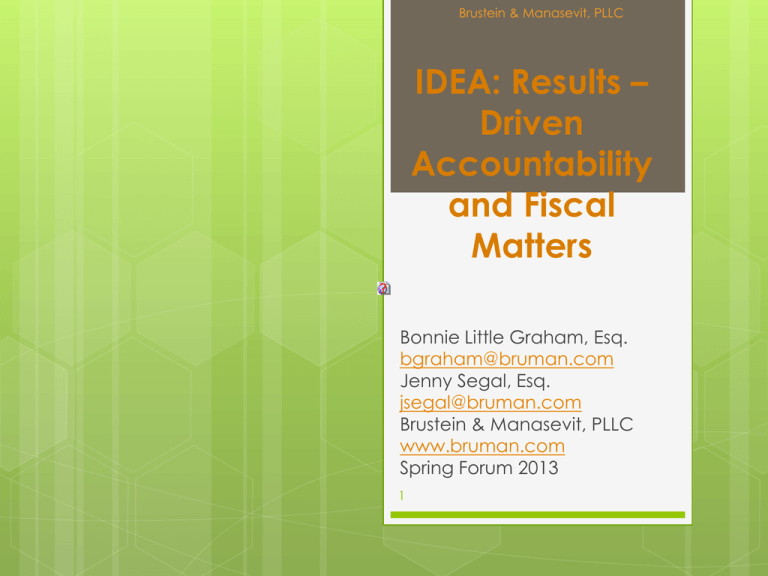
Brustein & Manasevit, PLLC IDEA: Results – Driven Accountability and Fiscal Matters Bonnie Little Graham, Esq. bgraham@bruman.com Jenny Segal, Esq. jsegal@bruman.com Brustein & Manasevit, PLLC www.bruman.com Spring Forum 2013 1 2 Agenda Results-Driven Accountability Maintenance of Effort Provision Supplement not Supplant Provision Excess Costs Provision Brustein & Manasevit, PLLC 3 RESULTS-DRIVEN ACCOUNTABILITY IN SPECIAL EDUCATION Brustein & Manasevit, PLLC 4 IDEA Monitoring U.S. Department of Education Office of Special Education Programs (OSEP) monitors States’ implementation of IDEA Parts B and C States monitor local education agencies’ (LEAs) implementation of Part B and early intervention services (EIS) programs’ implementation of Part C Brustein & Manasevit, PLLC 5 Monitoring Priorities “The primary focus of Federal and State monitoring activities shall be on – Improving educational results and functional outcomes for all children with disabilities; and Ensuring that States meet the program requirements under this part with a particular emphasis on those that are closely related to improving education results for children with disabilities.” IDEA Sec. 616(a)(2) Brustein & Manasevit, PLLC 6 “Using such qualitative indicators as are needed to adequately measure performance in the following priority areas: Provision of FAPE in the LRE State exercise of general supervisory authority including: child find, effective monitoring, use of resolution sessions, mediation, voluntary binding arbitration, and transition services Disproportionate representation Other relevant information and data, including data provided by States under section 618.” Brustein & Manasevit, PLLC 7 Current System of Accountability Determination based on totality of information including: Annual Performance Report (APR)/State Performance Plan (SPP) Monitoring Other Public information Brustein & Manasevit, PLLC 8 Determination Process Meets Requirements Provided valid and reliable data for all indicators Demonstrated substantial compliance for compliance indicators (4B, 9, 10, 11, 12, 13, 15,16, 17, 20) Needs Assistance State that did not meet requirement, need intervention, or need substantial intervention Needs Intervention Very low compliance data Failure to provide reliable data for a compliance indicator Longstanding noncompliance for a key IDEA requirement Needs Substantial Intervention Failure to comply significantly affected the core requirements of the program Brustein & Manasevit, PLLC 9 Trend in National Average Percent of Timely Transition of Students with Disabilities Brustein & Manasevit, PLLC 10 Trend in National Average Percent of Accurate Data Brustein & Manasevit, PLLC 11 Trend in National Average Percent of Written Complaints Timely Resolved Brustein & Manasevit, PLLC 12 Trend in National Average Percent of Timely Evaluations of Students with Disabilities Brustein & Manasevit, PLLC 13 Comparison of Outcomes for Students with Disabilities Brustein & Manasevit, PLLC 14 Trend in National Average Reading Proficiency for Students with Disabilities Brustein & Manasevit, PLLC 15 Trend in National Average Math Proficiency for Students with Disabilities Brustein & Manasevit, PLLC 16 Components of Accountability System to be Aligned within RDA APR - indicators will be designed to measure outcomes most closely aligned with improving results. State Status Determinations – designation “meets requirements” should acknowledge State’s effectiveness in improving outcomes for children with disabilities relative to other States. Determinations will be based on overall performance on a set of priority indicators and other relevant data rather than just compliance indicators. Monitoring and Technical Assistance – differentiated system of monitoring and TA will support State with most significant needs for improvement. Based on data from priority indicators. Brustein & Manasevit, PLLC 17 OSEP 13-6 Memorandum (Issued 12/2012) Revised SPP and (FY) 2011 APR due Feb. 15, 2013 ED is considering how it will use data from results indicators in making determinations in spring 2013. Developing “State Results Matrix” and “State Compliance Matrix” Example: State Assessments Brustein & Manasevit, PLLC 18 OSEP Notice of Proposed SPP/APR Revisions (April 15, 2013) Proposed revisions are based on the following principles: Align with RDA vision and goals Reduce duplication and reporting burden Retain consistent data sources and measurements. Brustein & Manasevit, PLLC 19 OSEP Notice of Proposed SPP/APR Revisions (April 15, 2013) (Cont.) Major Proposed Revisions: Combine SPP/APR into one document Collect SPP/APR through online submission Remove: “Timely correction of noncompliance” (Part B, ind. 15/ Part C, ind. 9) –though will continue to be monitored through compliance indicators. “Timely and accurate data” (Part B, ind. 20/ Part C, ind. 14)- though OSEP will continue to analyze data already available to ED. Brustein & Manasevit, PLLC 20 OSEP Notice of Proposed SPP/APR Revisions (April 15, 2013) (Cont.) Report only on slippage when State did not meet its target; no requirement to report on progress (EDGAR 80.40(b)(2)) State Systems Improvement Plan (SSIP) – replaces reporting on improvement activities by indicator. New Part B, ind. 17/ Part C, ind. 11 A comprehensive, ambitious and achievable plan for improving results. Brustein & Manasevit, PLLC 21 OSEP Notice of Proposed SPP/APR Revisions (April 15, 2013) (Cont.) SIPP- Three Phases Phase I – (must include with 2015 SPP/APR submission for FFY 2013) Data analysis identification of the focus for improvement infrastructure to support improvement and build capacity theory of action. Phase 2 -(must include with 2016 SPP/APR submission for FFY 2014) Infrastructure development Support for LEA implementation of evidence-based practices Evaluation plan Phase 3 - (must include with 2017- 2020 SPP/APR submissions for FFY 2015-2018) Results of ongoing evaluation and revisions to SPP. Brustein & Manasevit, PLLC 22 Excess Cost Brustein & Manasevit, PLLC 23 Excess Cost Requirement The excess cost requirement prevents an LEA from using funds provided under Part B of the Act to pay for all of the costs directly attributable to the education of a child with a disability. Exception: Children with disabilities ages 3-5 and 18-21 if local or State funds are not available. 34 CFR 300.202(b)(1) Brustein & Manasevit, PLLC 24 What is an Excess Cost? Costs in excess of the average annual per-student expenditures in an LEA during the preceding school year for an elementary school or secondary school student, as may be appropriate, and that must be computed after deducting amounts received under – IDEA Part B; Title I, Part A ESEA; Title III, Parts A and B of the ESEA; Any State or local funds expended for programs that would qualify for assistance under any of the grant programs described above); and Capital outlay or debt services. 34 CFR 300.16 Brustein & Manasevit, PLLC 25 How to Calculate Excess Costs? Calculate elementary school students separately from secondary school students. 34 CFR §300.16 Brustein & Manasevit, PLLC 26 Four Steps: Step 1: LEA must determine total amount of expenditures for elementary school students from all sources-local, State and federal (including Part B)-in the proceeding school year. (Less Capital outlay and debt services) State and Local + Federal funds – capital outlays = tax funds and debt Total Expenditures Less Capital Outlays and Debt Brustein & Manasevit, PLLC 27 Step 2: Subtract from the total expenditures less capital outlays and debt: IDEA Part B; Title I, Part A ESEA; Title III, Parts A and B of the ESEA; and Any State or local funds expended for programs that would qualify for assistance under any of the grant programs described above) = Total expenditures less capital outlay and debt, minus deductions Brustein & Manasevit, PLLC 28 Step 3: Determine the average annual student expenditure: (total expenditures less capital outlay and debt minus deductions)/(average number of students) = Average annual student per expenditures Brustein & Manasevit, PLLC 29 Step 4: Determine the total minimum amount of funds the LEA must spend for the education of its elementary school children with disabilities (not including capital outlay debt service): (Number of children with disabilities in LEA elementary schools) X (average annual per student expenditure) = (Total minimum amount LEA must spend for education of children with disabilities before using part B funds) Brustein & Manasevit, PLLC 30 SEA Exceptions SEA providing direct services to children with disabilities to make FAPE available: May use Part B funds from State set aside OR Part B payments that would have otherwise been available to an LEA for the purpose of serving those children Does not need to comply with excess cost requirement 34 CFR §§ 300.175, 300.227(a)(2)(ii) Brustein & Manasevit, PLLC 31 IDEA, Part B State and Local Maintenance of Effort Brustein & Manasevit, PLLC 32 State Maintenance of Effort (MOE) • A State must not reduce the amount of State financial support for special education and related services for children with disabilities below the amount of that support for the preceding fiscal year. • Must use ALL State funds!! May not use Medicaid reimbursements towards SEA MOE requirements. Brustein & Manasevit, PLLC 33 Grant Application FY 2013 MOE Section • States must provide in whole dollars the total amount of State financial support made available for special education and related services for children with disabilities by year for the State fiscal years included in the application. • Include state funds provided to LEAs, the SEA, and other state agencies for that purpose Previously, States only affirmed that they were in compliance with MOE requirements Brustein & Manasevit, PLLC 34 State MOE Waiver IDEA Waiver ONLY applies to State MOE! (not LEA MOE) ED may waive SEA MOE (for one FY at a time) if ED determines that a waiver would be equitable due to: Exceptional or uncontrollable circumstances such as a natural disaster or a precipitous & unforeseen decline in State financial resources; or The SEA meets Supplement Not Supplant Waiver Requirements. IDEA Regs §§300.163(c) and 300.164 Does not reduce State MOE for subsequent years Brustein & Manasevit, PLLC 35 State MOE Waiver (cont.) ED wants to make sure any reduction in State SPED funds is not greater than the % reduction in revenues experienced by the State (SPED treated equitably). Factors considered: State’s revenues and extent of decrease based on exceptional or uncontrollable circumstances State’s total appropriations for current versus prior year State’s appropriations for other agencies State’s compliance with Implementing IDEA, Part B and performance record Other available funds to mitigate effects of waiver Brustein & Manasevit, PLLC 36 Failure to Meet State MOE South Carolina Consequences ED reduces allocation for FY following the FY in which the State fails to comply. for failure to maintain support: March 2013- Stopgap spending bill, Section 1514 of H.R. 933. Penalty will not continue perpetually. Reduction only for the year(s) out of compliance. Reduction is the same amount by which the State fails to meet the requirement. Section 1514 of H.R. 933 - reduced funding taken away from a State that fails to make MOE will be split among other States. Following year reverts back to previous level of effort. Brustein & Manasevit, PLLC 37 Local-level Maintenance of Effort (MOE) An LEA may not use its Part B funds to reduce the level of expenditures for the education of children with disabilities made by the LEA from local funds below the level of those expenditures for the preceding fiscal year. 34 CFR 300.203(a) Brustein & Manasevit, PLLC 38 Local-level MOE (cont.) Four ways to calculate Local MOE: 1. Comparison of total expenditures using local funds only, 2. Comparison of total expenditures using State and local funds, 3. Comparison of the per pupil amount using local funds only, or 4. Comparison of the per pupil amount using State and local funds. 34 CFR 300.203(b) Brustein & Manasevit, PLLC 39 Local-level MOE Reductions Allowable reductions: 1. 2. 3. 4. 5. Voluntary departure of special education or related services personnel A decrease in the enrollment of children with disabilities The assumption of cost by the SEA’s high cost fund An exceptionally costly child has left the agency’s jurisdiction, aged out of the eligibility age-range, or no longer needs the program of special education, or The termination of costly expenditures for long-term purchases, such as the acquisition of equipment. 34 CFR 300.203(b) Brustein & Manasevit, PLLC 40 Local-level MOE - Optional Flexibility • If there is an increase in the LEA’s allocation, compared to the previous FY allocation, • Then the LEA may reduce the level of expenditures otherwise required by not more than 50% of the amount of excess in allocation, • But the LEA must use an amount of local funds equal to the MOE reduction to carry out activities that could be supported with ESEA funds, regardless of whether the LEA is using ESEA funds for those activities. (IDEA Regs Section 300.205) ▫ This will reduce the following year’s MOE as well! Brustein & Manasevit, PLLC 41 Local-level MOE - Optional Flexibility (cont.) • Flexibility may be unavailable if: ▫ ▫ ▫ ▫ SEA determines that LEA is unable to establish and maintain programs of FAPE that comply with Part B and § 613(a); or The SEA took action against an LEA under § 613(a) of IDEA; SEA has taken action against an LEA under § 616 and subpart F of regulations; or LEA is identified as “significantly disproportionate.” Brustein & Manasevit, PLLC 42 Local-level MOE – Optional Flexibility & CEIS • • The amount of LEA MOE reduction that an LEA can take is affected by an LEA’s use of Part B funds for coordinated early intervening services (CEIS). Therefore, must subtract any CEIS set-aside from any potential LEA MOE reduction! Brustein & Manasevit, PLLC 43 Local-level MOE (cont.) • • Consequences for violation: SEA can not reduce an LEA’s current or future allocation. ED would handle an LEA MOE violation by seeking a recovery of funds from the SEA. The level of recovery would depend on the degree to which the LEA failed to maintain effort, but would not exceed the amount of the LEA’s subgrant for the year in question. (See OSEP policy letter, July 26, 2006, to Carol Ann Baglin on www.bruman.com ) Up to SEA to recover funds from LEA Brustein & Manasevit, PLLC 44 Local-level MOE (cont.) Consequences for violation: The LEA’s MOE requirement reverts to the level set the last time the LEA met MOE! Letter to the Center for Law and Education, Kathleen Boundy, dated April 4, 2012 on www.bruman.com Rescinds previous Letter to NASDSE Executive Director Bill East, dated June 16, 2011. What about LEAs that relied on June 2011 letter to reduce effort levels??? Brustein & Manasevit, PLLC 45 Supplement not supplant Brustein & Manasevit, PLLC 46 SEA Supplement Not Supplant • • Part B funds must be used to supplement and increase the level of Federal, State and local funds expended for special education and related services provided to children with disabilities, and in no case supplant those Federal, State and local funds. A State may use funds it retains for State admin and other State-level activities without regard to the prohibition on supplanting other funds 34 CFR 300.164 Brustein & Manasevit, PLLC 47 LEA Supplement Not Supplant • Part B funds must be used to supplement State, local and other Federal funds (used for providing services to children with disabilities) • If LEA meets MOE, then LEA meets supplement /not supplant requirements • No particular cost test • ARRA Guidance, April 2009 34 CFR 300.202 Brustein & Manasevit, PLLC 48 LEA Supplement Not Supplant (cont.) • Notwithstanding 300.202 (SNS), 300.203 (MOE), and 300.162 (Commingling), funds provided to an LEA may be used for: • • • Services and aids that also benefit nondisabled children Early intervening services High cost special education and related services 34 CFR 300.208 Brustein & Manasevit, PLLC 49 CEIS and Supplement Not Supplant CEIS must supplement any ESEA activities or services. 34 CFR 300.226(e) Model example: 1. CEIS and local funds serve total population – CEIS for eligible CEIS students 2. Title I provides Response to Intervention to Title I students and CEIS supplements Brustein & Manasevit, PLLC 50 Exceptions to SNS State Administrative Set-Aside IDEA Regs § 300.704(d) Supplement Not Supplant (cont.) IDEA Regs § 300.704(d) Other State-Level Activities Set-Aside Regs § 300.133(d) Equitable Services supplement IDEA, Part B(reverse funds must be used toIDEA supplement not supplant) and not supplant State, local, and other Federal funds. Services and aids that also benefit nondisabled children IDEA Regs § 300.208(a)(1) Early Intervening Services IDEA Regs § 300.208(a)(2) High Cost Fund IDEA Regs § 300.208(a)(3) Administrative Case Management IDEA Regs § 300.208(b) Schoolwide Funds (only amount consolidated) IDEA Regs § 300.206(a) Brustein & Manasevit, PLLC 51 Questions? Brustein & Manasevit, PLLC 52 Disclaimer This presentation is intended solely to provide general information and does not constitute legal advice. Attendance at the presentation or later review of these printed materials does not create an attorneyclient relationship with Brustein & Manasevit, PLLC. You should not take any action based upon any information in this presentation without first consulting legal counsel familiar with your particular circumstances. Brustein & Manasevit, PLLC
